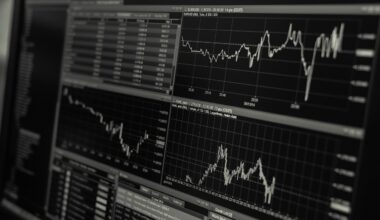Applying Time Series Analysis in Quantitative Market Research
Time series analysis is an essential method used in quantitative market research to analyze data points collected or recorded at specific time intervals. This methodology helps researchers identify trends, seasonal patterns, and potential cyclical movements in market behavior. By collecting market data methodically over time, businesses can acquire valuable insights driving their strategic decision-making. Understanding trends allows companies to make forecasts based on historical patterns, enhancing their ability to predict consumer behavior or market shifts. A successful time series analysis involves several steps, including data collection, preprocessing, and model selection. Data collection must be consistent and accurate to ensure that outcomes reflect the market dynamics genuinely. Preprocessing steps include cleaning the data and addressing any inconsistencies. Popular models include ARIMA, Seasonal Decomposition of Time Series (STL), and Exponential Smoothing, each tailored to handle different data types and requirements. By applying these models effectively, businesses can derive actionable insights from data trends, significant in shaping their marketing strategies. Ultimately, time series analysis serves as a backbone to quantitative research by ensuring that conclusions drawn are rooted in empirical evidence.
Seasonal analysis is a critical component of time series analysis that assists in understanding recurring patterns that occur at specific intervals. Many markets exhibit seasonality, influenced by factors such as holidays, weather changes, or cultural events. For example, retail sales typically surge during holiday seasons, while other sectors may have their peaks at different times. Identifying these seasonal trends enables businesses to optimize their product offerings and marketing campaigns effectively. Furthermore, understanding fluctuations in consumer demand allows companies to enhance inventory management and production schedules to align with market needs. Utilizing models like Seasonal Decomposition adds a layer of sophistication to quantitative research, providing clarity on these predictable patterns. Researchers segment data into trend, seasonal, and irregular components, facilitating a more straightforward analysis of underlying causes. This knowledge empowers businesses to adapt quickly and capitalize on their identified seasonal opportunities. Moreover, seasonality can lead to better resource allocation, reduced wastage, and improved customer satisfaction through timely deliveries and promotions. Overall, incorporating seasonal analysis into time series significantly enriches market research outcomes.
Forecasting and Business Applications
Forecasting is one of the primary objectives of time series analysis within quantitative market research, providing organizations with insights that can shape their future strategies. By utilizing forecasts, businesses can anticipate customer demand, allowing for optimized inventory and resource management. The accuracy of forecasting models is paramount, as misleading predictions can lead to either excess stock or sales shortages, both detrimental to profit margins. Organizations leverage various techniques for forecasting, including ARIMA (AutoRegressive Integrated Moving Average) and Holt-Winters methods, which accommodate trends and seasonal variations. These techniques vary in terms of complexity and suitability, with businesses selecting models aligned with their data characteristics and forecasting horizon. Additionally, employing multiple forecasting models in tandem can yield more robust outcomes. When a company successfully implements forecasting derived from time series analysis, it creates a competitive edge, enabling it to respond rapidly to market changes. Such agility contributes significantly to customer satisfaction and retention. Ultimately, predicted outcomes derived from historical data feedback loops play a crucial role in shaping strategic initiatives for improved operational efficiency.
Another integral aspect of time series analysis is the establishment of benchmarks to assess marketing performance. By evaluating past data, marketers can set realistic performance targets for future campaigns and align their strategies with established performance metrics. These benchmarks can help identify key performance indicators (KPIs) for various marketing activities, such as conversion rates or engagement levels across distinct campaigns. In this manner, researchers can accurately gauge the effectiveness of marketing initiatives and decide whether or not to alter their approach. Continuous monitoring of performance metrics against these benchmarks enables businesses to maintain a competitive edge. Time series analysis equips firms to pivot marketing strategies based on new data, encouraging a culture of flexibility and insight-driven decision-making. Moreover, leveraging automated analytics platforms facilitates swift adjustments in strategy, ensuring businesses remain responsive to dynamic market conditions. Such adaptability further fosters innovation, ultimately leading organizations to explore new market opportunities they may have previously overlooked. The strategic insight obtained from robust benchmarks rooted in time series allows companies to navigate complexities in today’s market landscape.
Data Visualization in Time Series Analysis
Data visualization plays a pivotal role in the effectiveness of time series analysis, allowing stakeholders to grasp trends and patterns rapidly. By employing visual tools like line charts, bar graphs, and other formats, analysts can present complex data insights accessibly. Visualization transforms raw data into easily interpretable metrics, enabling marketers to identify performance fluctuations at a glance. This ease of interpretation is crucial for effective communication with stakeholders, ensuring that insights derived from time series analysis inform decision-making at all levels of an organization. Interactive dashboards also provide a platform for dynamic reporting, allowing businesses to explore data in real-time. Furthermore, visualization aids in the identification of outliers or anomalies in data that could signify important shifts in market behavior. By promptly highlighting these fluctuations, organizations can enact timely interventions. Additionally, incorporating data storytelling techniques enhances these visualizations, creating compelling narratives that drive engagement among stakeholders. Ultimately, effective data visualization transforms time series insights, ensuring that findings resonate and inspire actions. This paradigm shift from mere data presentation to impactful storytelling fosters a culture of informed decision-making across all organizational tiers.
To fully leverage time series analysis, organizations must address challenges that may arise during implementation. Issues such as missing data, irregular intervals, or external shocks can impact the reliability of analyses significantly. Establishing protocols for data collection is imperative to minimize these challenges and promote best practices in quantitative research. By implementing automated data gathering processes, businesses can ensure that the statistics relevant to their market are accurately captured over time. Moreover, rigorous data quality assessments help organizations to maintain the integrity and reliability of the datasets involved. Statistical techniques, such as seasonal adjustment and smoothing, also contribute to mitigating the ripple effects of data irregularities. Furthermore, engaging with experts in time series methodologies allows organizations to refine their analytical approaches continually. By embracing an iterative mindset focused on continual improvement and adaptation, companies can enhance the overall effectiveness of their market research initiatives. Ultimately, recognizing and addressing potential pitfalls in time series analysis is vital for developing actionable insights reliably. Organizations are better positioned to navigate complex market dynamics through diligent and proactive management of their data.
Conclusion and Future Directions
In summary, applying time series analysis in quantitative market research offers profound benefits for organizations looking to enhance their strategic capabilities. Through sophisticated forecasting techniques and data-driven decision-making, businesses can refine their approach to market dynamics. The interplay between seasonal trends and the identification of performance benchmarks creates a comprehensive framework for effective marketing strategies. Additionally, empowering stakeholders with data visualizations facilitates better understanding and reporting of critical market insights. Future advancements in technology, such as artificial intelligence and machine learning, will likely further enrich time series analysis, enabling more sophisticated predictive models. As organizations evolve, the need for agile and responsive market research will only intensify, requiring teams to embrace innovative methodologies continuously. Investing in training and development in time series techniques will cultivate a workforce equipped to tackle increasingly complex market challenges. By prioritizing time series analysis and integrating it into the market research process, organizations position themselves to remain competitive and thrive in an ever-changing landscape, driving growth and informing their strategic initiatives confidently.
Time series analysis is an essential method used in quantitative market research to analyze data points collected or recorded at specific time intervals. This methodology helps researchers identify trends, seasonal patterns, and potential cyclical movements in market behavior. By collecting market data methodically over time, businesses can acquire valuable insights driving their strategic decision-making. Understanding trends allows companies to make forecasts based on historical patterns, enhancing their ability to predict consumer behavior or market shifts. A successful time series analysis involves several steps, including data collection, preprocessing, and model selection. Data collection must be consistent and accurate to ensure that outcomes reflect the market dynamics genuinely. Preprocessing steps include cleaning the data and addressing any inconsistencies. Popular models include ARIMA, Seasonal Decomposition of Time Series (STL), and Exponential Smoothing, each tailored to handle different data types and requirements. By applying these models effectively, businesses can derive actionable insights from data trends, significant in shaping their marketing strategies. Ultimately, time series analysis serves as a backbone to quantitative research by ensuring that conclusions drawn are rooted in empirical evidence.


